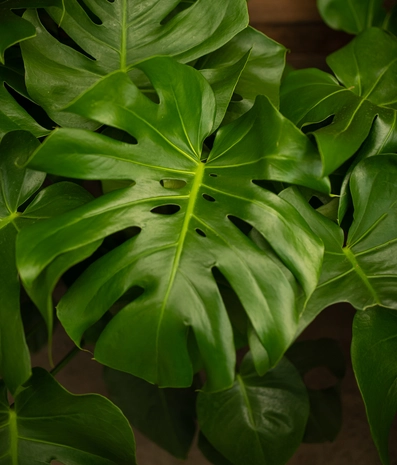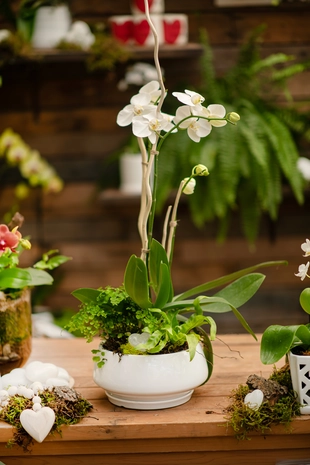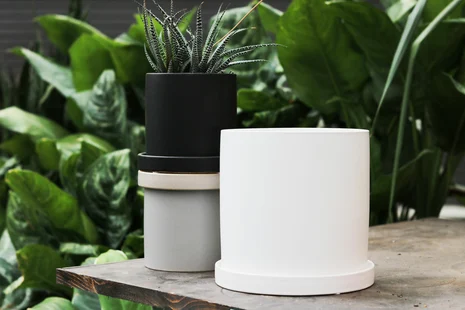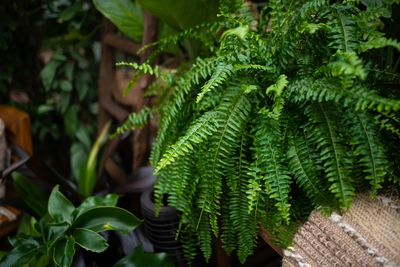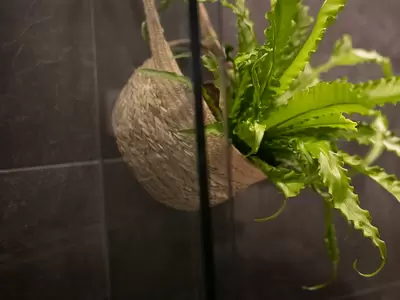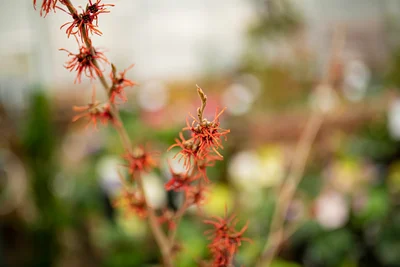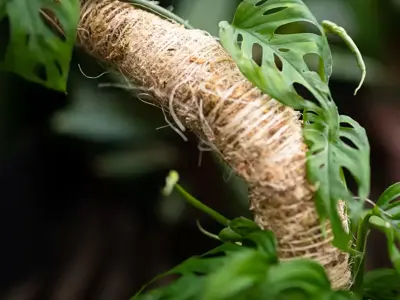
Written by Ingrid Hoff
The last two years have played havoc on many people’s travel plans, resulting in an abundance of people suffering from what I have termed “travel-itis” or missing travel to tropical destinations to blow off the winter blues. The idea of standing in a verdant, lush, humid, warm, colourful, vibrant space when you are actually standing in your boots freezing your keister off on a dreary winter day is somewhat, well... sad. But if you are suffering from “travel-itis” then know you don’t need to suffer anymore, you can create your own tropical jungle vibe in your space by getting yourself some tropical vines. If you can’t go to the jungle then create your own.
Now, when I say tropical vines, I don’t mean vines like the type that Tarzan swings on, I’m mean any plant that can either cascade down or climb up. Visually, having a plant that can climb or hang creates a new dimension, the vertical dimension. There is also the joy of seeing the change in your plant as it scrabbles along a wall or trellis, or the visual appeal of waves of green coming down over a bookcase. Another benefit of growing your plants in a vertical space is… well… personally I’m starting to run out of prime real estate with lovely bright indirect light in my home. I should note that it is not, as my husband puts it, that I have too many plants, it’s that I don’t have enough space. So, I’m getting creative. Just image how lovely it would look to train a vine to grow over a door, around a window, or just cascade down a wall, shelf or stylish wall sconce.
Often whether a plant cascades or climbs in a matter of preference. Most vining plants will happily do either, although there are a few exceptions. If you want them to climb you need to give them something to climb on, perhaps a little trellis, moss pole, or even just the wall/bookcase. Sometimes they might need a little help in the form of some string to tie them to the trellis/moss pole, or if you want to train it along a wall then get yourself some easy-to-remove sticky clear plastic wall hooks.
Don't be afraid to prune your vining tropicals to keep them compact and bushy. I’ve seen more than a few that have gotten out of control with long leggy vines that scramble just a bit too much. Cut the stems just above a node, which is a swelling or where a leaf joins, never in the middle of a stem.
Now that you know what to do it’s time to have a look at some of the fabulous plants available.
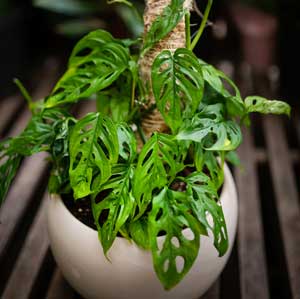 Swiss cheese plant (Monstera adonsonii) looks exactly like what you’d expect, with heart shaped leaves that are full of decorative cut-outs. A dark green coloured vine, it is perfect for a shady corner, and is just as happy cascading over a planter as it is scrambling up a trellis. Make sure to give it some humidity but never let it sit in water, in fact I let mine dry out slightly in-between watering.
Swiss cheese plant (Monstera adonsonii) looks exactly like what you’d expect, with heart shaped leaves that are full of decorative cut-outs. A dark green coloured vine, it is perfect for a shady corner, and is just as happy cascading over a planter as it is scrambling up a trellis. Make sure to give it some humidity but never let it sit in water, in fact I let mine dry out slightly in-between watering.
Porcelain flower or wax plant (Hoya carnosa), is an easy to grow and extremely long-lived succulent vine. When they bloom their flowers are extraordinary, a cluster of tiny pinkish velvety stars. Put your hoya where it can enjoy medium to bright indirect light but also some warmth and high humidity would be appreciated. One thing to never do is overwater them, in fact they do well drying out from time to time. There are a number of different types out there from ones with rolled/wavy leaves to ones with bright yellow variegation.
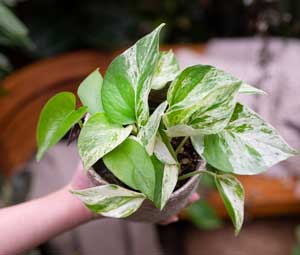 Pothos are a group of vigorous vines with heart shaped leaves that are revered for their ease of care. In fact, a common name for them is devil’s ivy because they seem impossible to kill. Able to handle both dark and light conditions they are a very forgiving plant. Some are variegated with green and white or yellow, others are a bright shiny green, there is even one (satin pothos) with a velvety silver leaf, and my favourite the neon pothos with golden/chartreuse colour. Don’t be afraid to cut back any vines that get too long, it will make your plant bushier and fuller looking.
Pothos are a group of vigorous vines with heart shaped leaves that are revered for their ease of care. In fact, a common name for them is devil’s ivy because they seem impossible to kill. Able to handle both dark and light conditions they are a very forgiving plant. Some are variegated with green and white or yellow, others are a bright shiny green, there is even one (satin pothos) with a velvety silver leaf, and my favourite the neon pothos with golden/chartreuse colour. Don’t be afraid to cut back any vines that get too long, it will make your plant bushier and fuller looking.
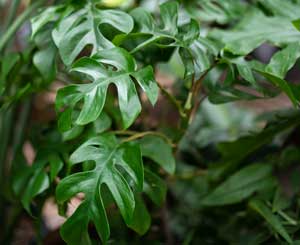 Rhaphidophora tetrasperma, sometimes called a mini monstera, it’s an aroid with a cut leaf similar looking to the oh-so-popular Monstera deliciosa. However, the leaves never get to the size of the monstera and it climbs. Make sure to give it bright indirect light, high humidity (it is native to Thailand), and don’t overwater but keep it nice and moist. Give it a moss pole to grow on or let it cascade. An interesting fact, recently a rare variegated form of this plant sold in New Zealand for over $8000.
Rhaphidophora tetrasperma, sometimes called a mini monstera, it’s an aroid with a cut leaf similar looking to the oh-so-popular Monstera deliciosa. However, the leaves never get to the size of the monstera and it climbs. Make sure to give it bright indirect light, high humidity (it is native to Thailand), and don’t overwater but keep it nice and moist. Give it a moss pole to grow on or let it cascade. An interesting fact, recently a rare variegated form of this plant sold in New Zealand for over $8000.
.jpg) String of pearls (Senecio rowleyanus) are perfect if you are looking for something a bit different. This succulent hanging plant is a mass of delicate looking bright green baubles (or pearls if you will). This is a plant that won’t climb but the cascading green pearls are better displayed as they hang anyways. Place it in a warm, dry space with bright indirect light and enjoy how easy it is to care for.
String of pearls (Senecio rowleyanus) are perfect if you are looking for something a bit different. This succulent hanging plant is a mass of delicate looking bright green baubles (or pearls if you will). This is a plant that won’t climb but the cascading green pearls are better displayed as they hang anyways. Place it in a warm, dry space with bright indirect light and enjoy how easy it is to care for.
Tradescantia ‘Nanouk’ is an extremely popular plant right now and it’s not hard to see why. With pink, cream, and green striped succulent-looking leaves that have bright fuchsia/purple undersides, it catches attention. Commonly called fantasy Venice, it also boasts small star-shaped white and yellow flowers, that emerge from pink buds. The great thing is if you are looking for colour then you get it year-round from the leaves. Easy to grow, give it bright indirect light (not enough light and you will lose the leaf colouration, too much direct light and you will see dark pink leaf spots that are an indication of sunburn), lots of humidity, and well-drained soil.
Callisia repens ‘Pink Panther’ is yet another eye-catching pink and green striped plant (quite similar looking to fantasy Venice) but just in a smaller more compact package. It’s kind of adorable, with dainty little green and lavender pink leaves. Give it bright indirect light, and don’t overwater (let it dry out in between watering).
Surrounding yourself with tropical houseplants is a must. It helps your mental and physical heath, and during the sometimes-dreary days of winter we spend a lot of time inside. Studies have shown that humans are hardwired to need access to nature and houseplants are the perfect way to get a constant fix, besides they add a layer of softness and interest to your home. Now while I love the idea of a fiddle leaf fig in the stylish planter (or perhaps a snake plant?) if you really want to ramp up your space and create a jungle vibe you need to get some climbing or cascading plants and start looking up, or perhaps down… your choice.

